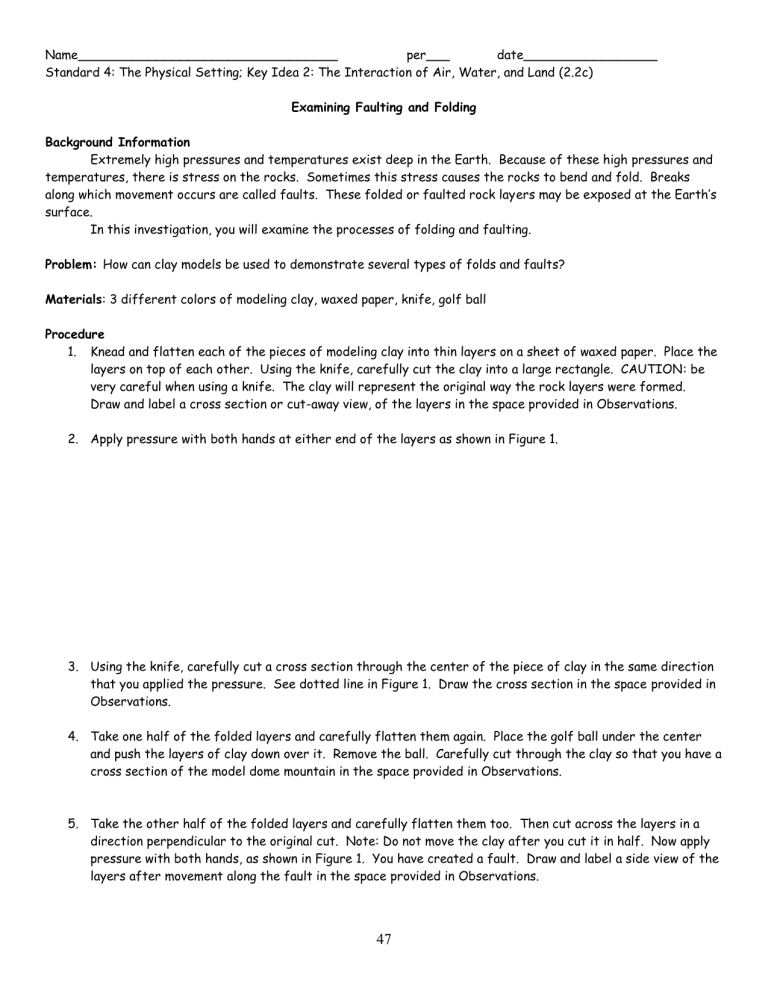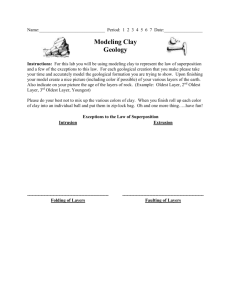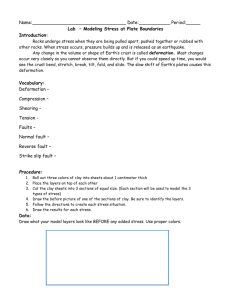Examing faulting and folding

Name_________________________________ per___ date_________________
Standard 4: The Physical Setting; Key Idea 2: The Interaction of Air, Water, and Land (2.2c)
Examining Faulting and Folding
Background Information
Extremely high pressures and temperatures exist deep in the Earth. Because of these high pressures and temperatures, there is stress on the rocks. Sometimes this stress causes the rocks to bend and fold. Breaks along which movement occurs are called faults. These folded or faulted rock layers may be exposed at the Earth’s surface.
In this investigation, you will examine the processes of folding and faulting.
Problem: How can clay models be used to demonstrate several types of folds and faults?
Materials: 3 different colors of modeling clay, waxed paper, knife, golf ball
Procedure
1.
Knead and flatten each of the pieces of modeling clay into thin layers on a sheet of waxed paper. Place the layers on top of each other. Using the knife, carefully cut the clay into a large rectangle. CAUTION: be very careful when using a knife. The clay will represent the original way the rock layers were formed.
Draw and label a cross section or cut-away view, of the layers in the space provided in Observations.
2.
Apply pressure with both hands at either end of the layers as shown in Figure 1.
3.
Using the knife, carefully cut a cross section through the center of the piece of clay in the same direction that you applied the pressure. See dotted line in Figure 1. Draw the cross section in the space provided in
Observations.
4.
Take one half of the folded layers and carefully flatten them again. Place the golf ball under the center and push the layers of clay down over it. Remove the ball. Carefully cut through the clay so that you have a cross section of the model dome mountain in the space provided in Observations.
5.
Take the other half of the folded layers and carefully flatten them too. Then cut across the layers in a direction perpendicular to the original cut. Note: Do not move the clay after you cut it in half. Now apply pressure with both hands, as shown in Figure 1. You have created a fault. Draw and label a side view of the layers after movement along the fault in the space provided in Observations.
47
Observations
Cross Section of Unfolded Clay Layers
Cross Section of Folded Layers
Cross Section of Dome Mountain
Cross Section of a Fault
48
Analysis and Conclusion
1.
According to your fist drawing, which rock layer would have been formed first? Last?
2.
Using your second drawing as a reference, answer these questions: a.
In a syncline were worn away, would you find the oldest rocks at the center or at the edge? Why? b.
In an anticline were worn away, would you find the oldest rocks at the center or at the edge? Why?
3.
How can you tell which side of a fault has risen in relation to the other side?
4.
How are the processes of mountain and valley formation related to faulting?
5.
Why must a geologist be careful in trying to determine the ages of rock layers found in a fault or fold?
6.
When a rubber band is stretched too much, it will break. How does this relate to rock faulting?
49
BLANK PAGE
50





